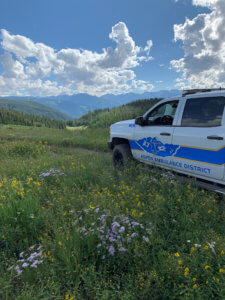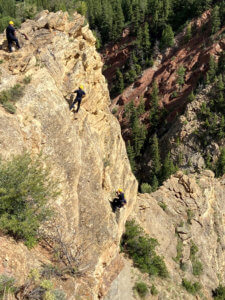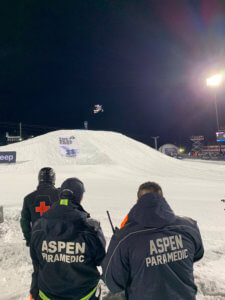Crews are trained to provide the highest standard of care.
The paramedics and EMTs who respond to ambulance calls in the upper Roaring Fork Valley are an elite team of medical professionals. Locals and visitors in Aspen and the surrounding area are served by the Aspen Ambulance District, an independent agency that has become one of the best in the business of saving lives in a remote, outdoor-oriented community surrounded by mountains and wilderness.
“The Aspen Ambulance District is a medical agency, hands down. Our goal is to save your life — and the best way we can do that is to provide an amazing level of care,” says Gabe Muething, Emergency Medical Services Director for the Aspen Ambulance District.

Many factors go into providing that high level of care that Muething describes. Training is one. Of the 32 employees at the Aspen Ambulance District, 27 are fully trained paramedics, and about half of them are further trained as critical care paramedics.
“Paramedics are something most communities love to have, but smaller communities struggle to attract and keep,” Muething explains. “In remote rural communities, the people who show up at the scene are likely to be first responders, typically police or firefighters with only a basic level of care provided.”
It’s fair to say that paramedics are really the jacks of all trades in medicine. They are responsible for dealing with all kinds of medical challenges in any location. They are trained to treat heart attacks where they occur, stop massive bleeding, and revive drowning victims. Almost every other form of medicine is specialized, with the exception of ER doctors and nurses.
Many communities in rural areas are served primarily by EMTs, who can operate an ambulance and provide a basic level of care. Cities and some resort communities like Aspen are lucky to have paramedics, who can administer drugs and perform basic emergency surgical procedures when the situation demands it.
Muething and the leadership at the Aspen Ambulance District encourage their employees to take it to the next level and train to become critical care paramedics. “Becoming a critical care paramedic requires significant training on top of all the rest, but that level of training allows us to turn our ambulances into rolling ICUs,” Muething says.

District paramedics and EMTs are also trained to deal with the geography and environment. Members of the Aspen Ambulance District team descend cliffs using ropes to reach people who have driven or fallen off high mountain roads and trails; they assist with swift water rescues; and they help to fight wildland fires with hand crews.
They are often on multi-agency responses with Mountain Rescue Aspen, Aspen Fire District, Roaring Fork Fire Rescue and the Pitkin County Sheriff.
Recently, paramedics had to retrieve a driver from the bottom of a cliff. “It’s critical for the victim that we get there as quickly as possible, but it’s also critical for the safety of rescue teams to gauge the severity of the injuries with falls and crashes off cliffs,” Muething says.
“If we can quickly gain access to the victim and determine if the person isn’t injured at all, or just has a broken ankle, we can communicate to the top for everybody to slow down. We can take our time, build a great system and increase our margin of safety.”
Muething says the Aspen Ambulance District was one of the first EMS agencies to train its paramedics so they could join hand crews on the front lines fighting wildfires. Wildland firefighters are in remote areas, often nowhere near roads. Historically, if someone was injured on a hand crew, the consequences could be dire because it was unlikely that anyone had training beyond first responder level. Now, hand crews have a fireline medic, who also assists with the fire fighting.
“If someone gets in trouble out there, the paramedic can stabilize them,” Muething says. “We know whether we need to call in a helicopter to get them out now, or bandage them up so they can hike back out.”
The Aspen Ambulance District was formed in 1982, and over the years built a reputation for swift service and high level care. It is responsible for covering 660 square miles from the top of Independence Pass to the top of Snowmass Canyon, with the exception of Snowmass Village, which is part of the Roaring Fork Fire Rescue Authority.
 The District is an independent taxing authority that collects property taxes with a 0.501 mill levy that supports its annual budget by covering gaps that come from underpayment by private insurance companies and the Medicare program. The District also supports its budget with fees for covering festival events, including Winter X Games, the Food & Wine Festival, Ideas Festival and others.
The District is an independent taxing authority that collects property taxes with a 0.501 mill levy that supports its annual budget by covering gaps that come from underpayment by private insurance companies and the Medicare program. The District also supports its budget with fees for covering festival events, including Winter X Games, the Food & Wine Festival, Ideas Festival and others.
“As the Director, I don’t let a penny go to waste,” Muething says. “We realize that every penny is important and that we’re asking our community to chip in to support a shared system that benefits everybody.”
The District works closely with Pitkin County government and Aspen Valley Hospital, which provides the staffing, budget oversight, administrative support and training collaboration.
“Being associated with the Hospital, especially one as progressive and capable as Aspen Valley Hospital, is certainly a great tool for us,” Muething says.
The relationship allows paramedics to work with Aspen Valley Hospital physicians and staff. Paramedics work alongside physicians in the ER and ICU to assure the paramedics’ skill levels remain exceptional and practiced. “Having the ability to work in partnership with ER physicians allows our paramedic staff to extend a high level of care outside the doors of a hospital to where a patient is found injured or ill,” Muething says.
Paramedics also transport Aspen Valley Hospital patients to other facilities when specialty care is needed. Due to the close relationship, paramedics are able to provide excellent continuity of care between hospitals. Paramedics are able to transport patients on multiple medications, maintain chest tubes and manage ventilators among other procedures while en route to another hospital. This level of critical care transport is extremely rare and almost unheard of in small communities.
Turnover at the Aspen Ambulance District is exceptionally rare. It’s been six years since Muething had to hire a new full-time employee, and two paramedics on the team have 35 years or more of service. In other communities, paramedics typically last five years with an employer.
In 2019, the District completed work on its new headquarters, which has six bays for ambulances and command vehicles. The building is fully equipped with rescue equipment for all geographic, natural and built environment challenges. The ground floor also has a room to store drugs, wash clothing and equipment, and a large meeting room for public and staff use.
“We really try to give back to the community with lectures and courses, although that was interrupted by the pandemic,” Muething says.
On the second floor, the residential area has private rooms for each paramedic on duty, allowing them to block all light and sound during down times to get the sleep they need. The common space has a full kitchen and dining area, large enough to serve everyone on duty and their families during holidays and special occasions.
The building was specifically designed to help the team manage the 24-hour shifts they work in a way that allows them to avoid burnout and exhaustion, which are common problems in the profession.
On a recent Monday afternoon, two staff members and an EMT student were on the deck discussing a textbook that was open on the table. Two others drove off in the ambulance to get lunch — they always drive the ambulance when they’re working because you never know when a call might come in.
“These are amazing people,” Muething says. “They spend a lot of time studying, trying to figure out how to do their jobs better. Paramedics are a very cerebral bunch. They love being the ones who go in, get the job done, save a person’s life and then quietly slip back to their normal lives. They aren’t after the attention and the glory, but they are proud of what they do. They are ridiculously proud of what they do. And, I am too.”

